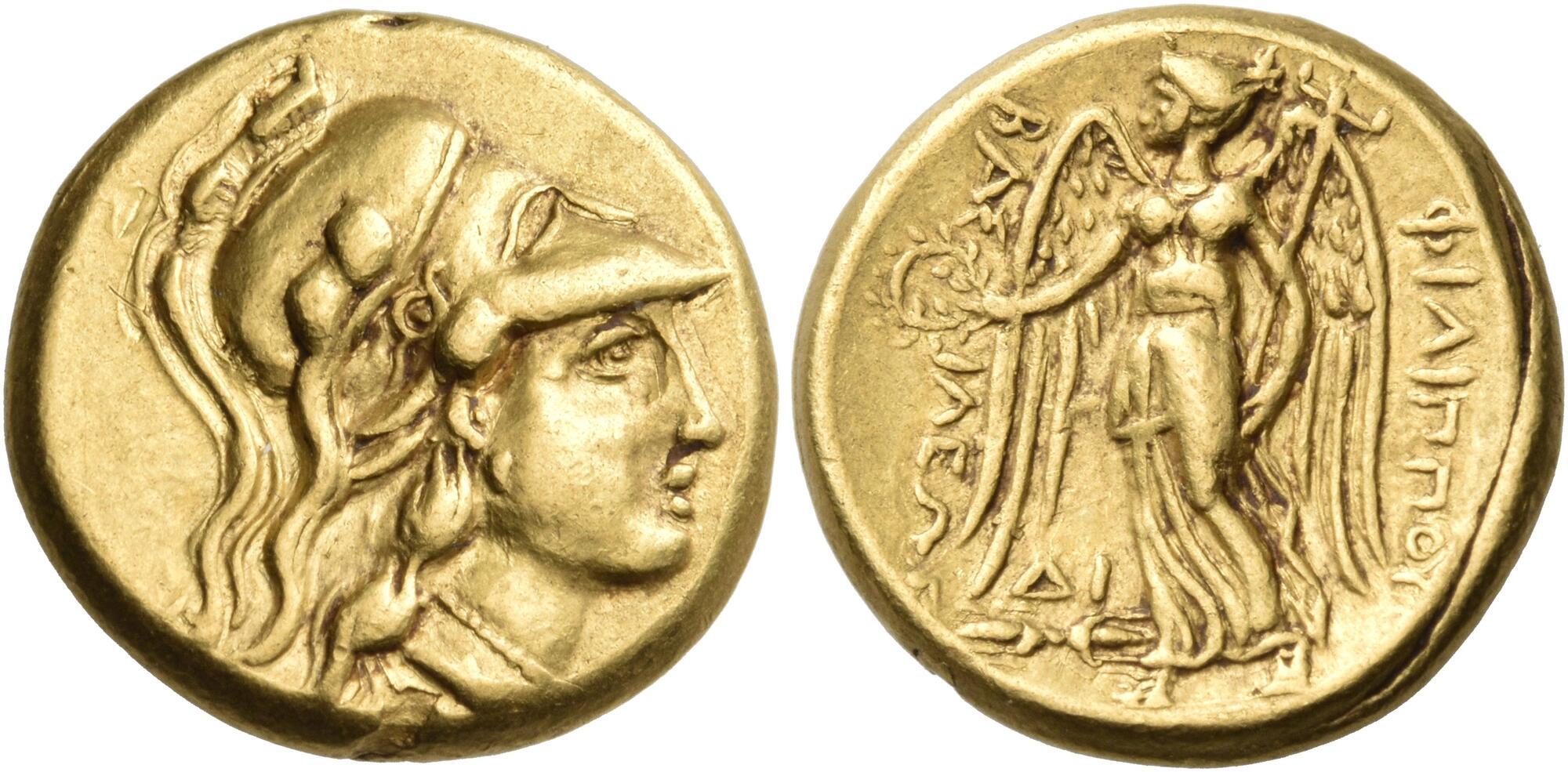S 39 - Aradus (Philip III), gold, staters (320-316 BCE)
From SILVER
320 BCE - 316 BCE Gold 33,298 kg
Description
| ObverseInscription or printing placed on the obverse.: | Head of Athena to right, wearing pendant earring, necklace and a crested Corinthian helmet adorned with two olive leaves (?) and a serpent coiled to right |
| ReverseInscription or printing placed on the reverse.: | BAΣΙΛΕΩΣ ΦΙΛΙΠΠΟΥ (Greek).Nike standing left, holding wreath in her right hand and stylis with her left, at feet to left, ΔΙ above thunderbolt |
Mint and issuing power
| MintIdentifies the place of manufacture or issue of a numismatic object.: | Aradus | Ancient regionAncient region.: | Phoenicia | Modern countryModern country: Syria | AuthorityIdentifies the issuing power. The authority can be "pretended" when the name or the portrait of X is on the coin but he/she was not the issuing power. It can also be "uncertain" when there is no mention of X on the coin but he/she was the issuing power according to the historical sources: | Alexander III the Great (Argead king, 336-323 BC), Philipp III Arrhidaeus (Argead king, 323-317 BC) |
Chronology
| FromIdentifies the initial date in a range assigned in a numismatic context. | 320 BCE | toIdentifies the final date in a range assigned in a numismatic context.. | 316 BCE | PeriodTime period of the numismatic object.: Hellenistic 323-30 BC |
Physical description
| MetalThe physical material (usually metal) from which an object is made.: | Gold |
Median weightMedian of the weights of numismatic objects (in grams). in grams | 8.56 | DenominationTerm indicating the value of a numismatic object. Examples: tetradrachm, chalkous, denarius.: | stater |
StandardStandard.: | Attic |
Image

S39 Arados stater philip.jpg [1]
References
| Die study referencePublication of the study: | Duyrat 20051Duyrat 2005, p. 30, n° 874-875, 878-879 (Group V, Series 3), p. 31, n° 899-903 (Group V, Series 5), p. 30-31, n° 924-932 (Group V, Series 6), p. 33, n° 981-985 (Group V, Series 9), p. 34, n° 1026-1031 (Group V, Series 11) | ||
| Coin series referenceReference to coin series study: | Price 19912Price 1991, n° P138 | ||
| Coin series web referenceCoin series web references: |
| ||
Obverse dies distribution
| FrequencyFrequency of specimen in distribution. ᵖ | Number of obversesNumber of obverse dies. ᵖ (o) | % (o) | Number of coinsNumber of coins. (n) | % (n) | Die nameName(s) of the die(s). |
| 1 | 4 | 30.77 | 4 | 13.79 | 16, 20, 23, 24 |
| 2 | 6 | 46.15 | 12 | 41.38 | 13, 14, 17, 19, 21, 22 |
| 4 | 2 | 15.38 | 8 | 27.59 | 15, 18 |
| 5 | 1 | 7.69 | 5 | 17.24 | 25 |
| Total | 13 of 13 | 99.99 | 29 of 29 | 100 |
Reverse dies distribution
no distribution is available
Quantification
| Number of obversesNumber of obverse dies. ᵖ (o) | 13 | Number of singletons (o1)The number of singleton coins. ᵖ | 4 |
| Number of reverse diesNumber of reverse dies. (r) | 18 | Number of coinsNumber of coins. (n) | 29 |
| Coins per obverse dieNumber of coins per obverse die. (n/o) | 2.23 | Coins per reverse dieNumber of coins per reverse die. (n/r) | 1.61 |
| Reverse per obverse ratioRatio of obverse dies divided by reverse dies. (r/o) | 1.38 | Percentage of singletons (o1)number of coins (n) divided by the number of singletons (o1) ᵖ | 30.77 % |
| Original number of dies (O) (Carter 1983 formula)The estimation of the number of coins according to Carter 1983 ᵖ | 19.45 | Coins struck if 20,000 as average productivity per dieCoins made if the average productivity for obverses (according to Carter) is 20,000. ᵖ | 389,000 |
| Original number of dies (O) (Esty 2011 formula)The estimation of the number of coins according to the singleton formula in Esty 2011 ᵖ (O) | 23.56 | Survival rate if 20,000 as average productivity per dieSurvival rate if average productivity is 20,000. ᵖ | 0.00007 |
| Coverage (o = % of O) (Esty 1984 formula)Esty 1984 - coverage (% of O) ᵖ (o = % of O) | 86.21% | Die productivity if survival rate 1/2,000Average productivity if survival rate is 1/2,000. ᵖ | 2,982.01 |
| Weight of silver (in kg) if 20,000 coins per die (O = Carter formula)Carter 1983 * Median weight * 20000 (*10 if gold or electrum) ᵖ | 33,298 kg <br /> 33,298 kg | Die productivity if survival rate 1/5,000Average productivity if survival rate is 1/5,000. ᵖ | 7,455.01 |
Remarks